MICROSCOPE-ANTIQUES.COM © 2013-21.
J. B. DANCER MICROSCOPE:
c. 1848
Signed on the foot: 'J.B. DANCER, OPTICIAN,
MANCHESTER'
Serial Number:None
Author: Barry Sobel, with the kind assistance of Brian Stevenson who provided some details about the history of this microscope model.
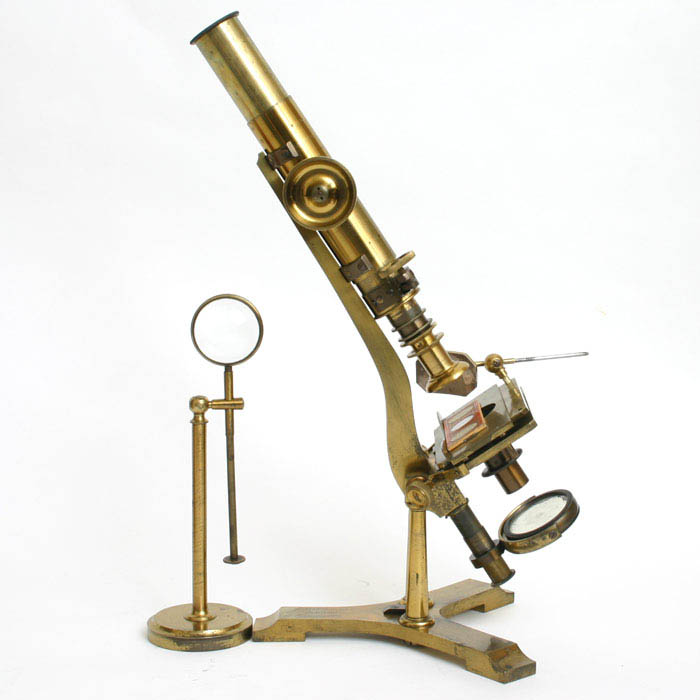
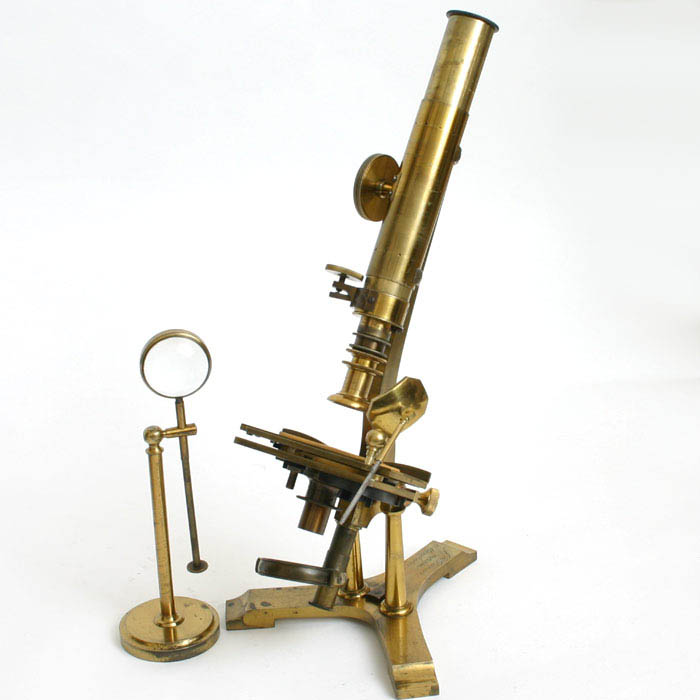
DESCRIPTION
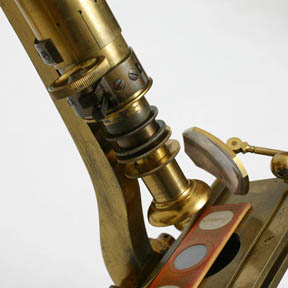
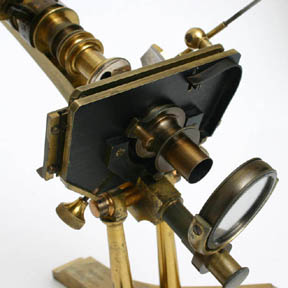 Signed on the foot 'J.B. DANCER, OPTICIAN, MANCHESTER', printed trade
lable on the inside of the door. It is very similar to the microscope
Dancer himself posed with in his microphotograph, #33. The microscope
stands on a 'Y' shaped brass foot with two slender turned columns
supporting the limb on trunions. At the bottom of the limb is a
circular column on which the plano-concave mirror can be slid up and
down. Above The mirror is a semi-mechanical stage with 2 knurled nuts
at the back allowing the user to move the stage in very small
increments; its intention is for coarse movement manually and fine
movement through these controls, each moving the sprung stage in 45
degree angles opposite of each other. The stage also has a main slide
carrier which can be slid back and forth but not side to side. The
underside of the stage is blackened and has an arm that can be swung
into the optical axis of the instrument which is used to hold the dark
well. The main body tube is held onto the limb via two brackets which
hold fast the external body tube allowing a second internal tube to be
used for focusing via an internal rack. This method was later dropped
for a fixed pinion at the back which racked the whole body tube up and
down. Very few with the type of coarse focusing seen here have
survived. The fine focus is via a knurled nut at the side acting on a
sprung lever which raises and lowers the objective. The RMS thread was
standard starting about 1858, so this instrument prob dates from that
year or earlier. The first drawer contains an interesting engraving of the microscope showing all of
its accessories (three of four quarters present) and other
paperwork relating to the powers of the lenses.
Signed on the foot 'J.B. DANCER, OPTICIAN, MANCHESTER', printed trade
lable on the inside of the door. It is very similar to the microscope
Dancer himself posed with in his microphotograph, #33. The microscope
stands on a 'Y' shaped brass foot with two slender turned columns
supporting the limb on trunions. At the bottom of the limb is a
circular column on which the plano-concave mirror can be slid up and
down. Above The mirror is a semi-mechanical stage with 2 knurled nuts
at the back allowing the user to move the stage in very small
increments; its intention is for coarse movement manually and fine
movement through these controls, each moving the sprung stage in 45
degree angles opposite of each other. The stage also has a main slide
carrier which can be slid back and forth but not side to side. The
underside of the stage is blackened and has an arm that can be swung
into the optical axis of the instrument which is used to hold the dark
well. The main body tube is held onto the limb via two brackets which
hold fast the external body tube allowing a second internal tube to be
used for focusing via an internal rack. This method was later dropped
for a fixed pinion at the back which racked the whole body tube up and
down. Very few with the type of coarse focusing seen here have
survived. The fine focus is via a knurled nut at the side acting on a
sprung lever which raises and lowers the objective. The RMS thread was
standard starting about 1858, so this instrument prob dates from that
year or earlier. The first drawer contains an interesting engraving of the microscope showing all of
its accessories (three of four quarters present) and other
paperwork relating to the powers of the lenses.
In addition to the mahogany case with seven drawers and
attached trade card, the accessories with the microscope include:
- a divisible objective
with matching external stop for the low power, and a matching
lieberlkuhn for high power
- Another objective with no additional fittings
- an outer element for another divisible objective now
lacking the inner element
- a polarizer which attaches under the stage with a matching
analyzer which screws on between the nosepiece and the objective
- a parabolic stage side reflector
- 2 darkwells which fit into the integral swing-out darkwell holder
under the stage
- a hand lens in a brass fitting
- dissecting scalpel
- a livebox
- a deep depression slide
- two brass plates with tiny holes; one with two holes, each
near the end, and another with three holes near the center
- an ocular micrometer in cardboard case
- a brass tool with two short rods protruding,as pictured in
the illustration, but of uncertain purpose, as it fits nothing on the
microscope this observer could find
- a small glass-stoppered bottle
- a single eyepiece labelled 'B'
- a brass piece which fits into the hole in the stage from
above and has a cylindrical depression with a small hole in its center
- a bench bullseye condenser
It is noted on the paper with tables of magnifications that
the ocular micrometer was to be used 'only' with the 'A' eyepiece
(which is unfortunately no longer present). Most of these accessories
are pictured in the enclosed engraving.
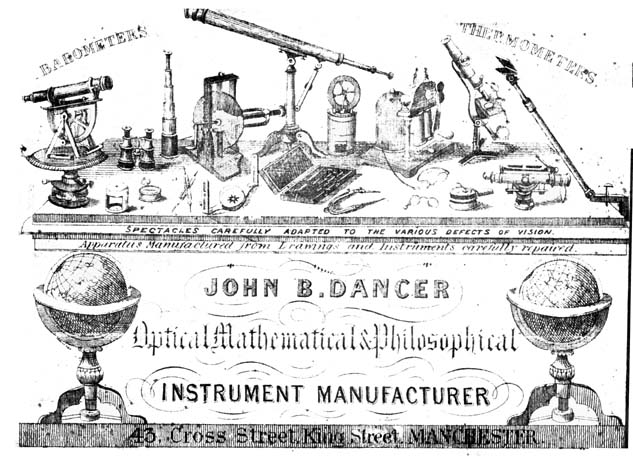
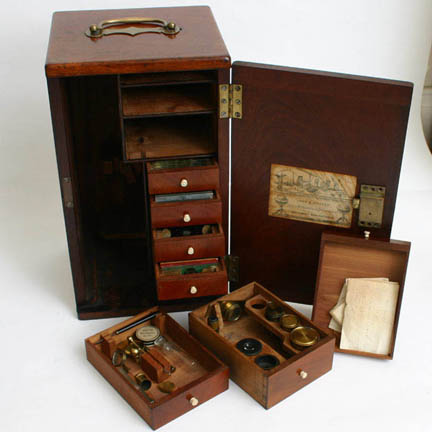
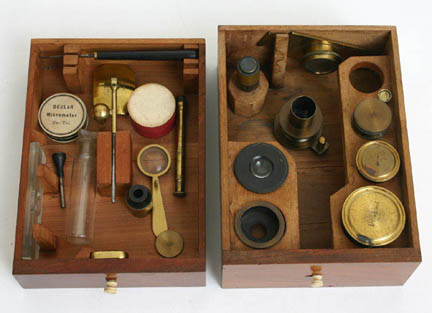
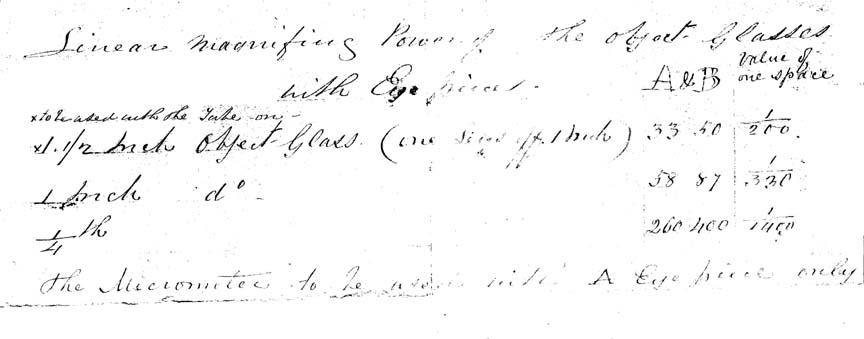
HISTORY OF J.B. DANCER MICROSCOPES
James Benjamin Dancer was a famous maker of all kinds of
scientific apparatus including instruments for physics experiments, microscopes, and others. He is well-remembered as the inventor of the microphotograph and much has been written about him. His microscopes are extremely well made and a priviledge to handle. In making microscopes, he shared two characteristics with James Smith. First was the use of divisible objectives and the second was that the shape of his liveboxes are very similar to Smith's. In addition, the design of this microscope is strikingly similar to the Powell and Lealand Iron Stand microscope, and an even earlier microscope, felt to be made by Andrew Ross. Both have a single large focusing knob at the side acting on an internal rack and they are of similar size. Both have similarly shaped limbs, stage shape and sizes. Dancer published a detailed broadside about this microscope when at 13 Cross Street. He was a 43 Cross street, the address on his trade card with this microscope, in 1848.
Other Dancer microscopes on this site include his Cloth Inspection Microscope and one of his thread counting microscopes.


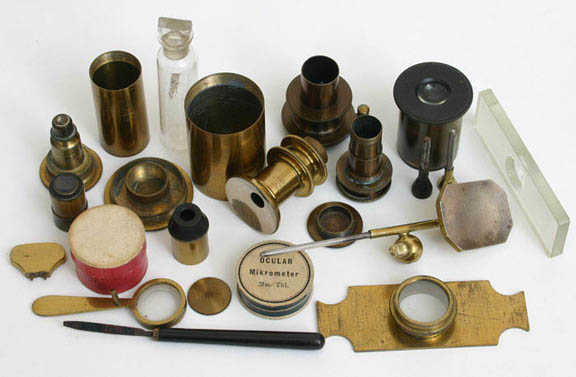



 Signed on the foot 'J.B. DANCER, OPTICIAN, MANCHESTER', printed trade
lable on the inside of the door. It is very similar to the microscope
Dancer himself posed with in his microphotograph, #33. The microscope
stands on a 'Y' shaped brass foot with two slender turned columns
supporting the limb on trunions. At the bottom of the limb is a
circular column on which the plano-concave mirror can be slid up and
down. Above The mirror is a semi-mechanical stage with 2 knurled nuts
at the back allowing the user to move the stage in very small
increments; its intention is for coarse movement manually and fine
movement through these controls, each moving the sprung stage in 45
degree angles opposite of each other. The stage also has a main slide
carrier which can be slid back and forth but not side to side. The
underside of the stage is blackened and has an arm that can be swung
into the optical axis of the instrument which is used to hold the dark
well. The main body tube is held onto the limb via two brackets which
hold fast the external body tube allowing a second internal tube to be
used for focusing via an internal rack. This method was later dropped
for a fixed pinion at the back which racked the whole body tube up and
down. Very few with the type of coarse focusing seen here have
survived. The fine focus is via a knurled nut at the side acting on a
sprung lever which raises and lowers the objective. The RMS thread was
standard starting about 1858, so this instrument prob dates from that
year or earlier. The first drawer contains an interesting engraving of the microscope showing all of
its accessories (three of four quarters present) and other
paperwork relating to the powers of the lenses.
Signed on the foot 'J.B. DANCER, OPTICIAN, MANCHESTER', printed trade
lable on the inside of the door. It is very similar to the microscope
Dancer himself posed with in his microphotograph, #33. The microscope
stands on a 'Y' shaped brass foot with two slender turned columns
supporting the limb on trunions. At the bottom of the limb is a
circular column on which the plano-concave mirror can be slid up and
down. Above The mirror is a semi-mechanical stage with 2 knurled nuts
at the back allowing the user to move the stage in very small
increments; its intention is for coarse movement manually and fine
movement through these controls, each moving the sprung stage in 45
degree angles opposite of each other. The stage also has a main slide
carrier which can be slid back and forth but not side to side. The
underside of the stage is blackened and has an arm that can be swung
into the optical axis of the instrument which is used to hold the dark
well. The main body tube is held onto the limb via two brackets which
hold fast the external body tube allowing a second internal tube to be
used for focusing via an internal rack. This method was later dropped
for a fixed pinion at the back which racked the whole body tube up and
down. Very few with the type of coarse focusing seen here have
survived. The fine focus is via a knurled nut at the side acting on a
sprung lever which raises and lowers the objective. The RMS thread was
standard starting about 1858, so this instrument prob dates from that
year or earlier. The first drawer contains an interesting engraving of the microscope showing all of
its accessories (three of four quarters present) and other
paperwork relating to the powers of the lenses.






